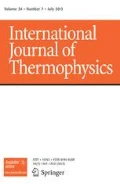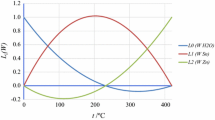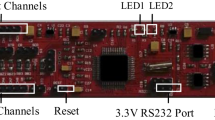Abstract
It is well known that different allowed interpolations using a given standard platinum resistance thermometer (SPRT) in overlapping subranges of the ITS-90 do not lead to identical results. This is termed Type 1 non-uniqueness, or subrange inconsistency (SRI), and it arises because of small incompatibilities in the SPRT characteristic \(W(T_{90})\) with respect to the ITS-90 reference function \(W_{r}(T_{90})\), such that the alternative low-order interpolations, fitted to the deviations \(W(T_{90})\) – \(W_{r}(T_{90})\) at different sets of fixed points, are not in general identical. To some extent SRI may be ‘scale-intrinsic,’ i.e., caused by incompatibilities between the resistance ratios, \(W_{r}(T_{90})\), specified at the fixed points of the ITS-90, and hence the same for all SPRTs. However, it has been found that the SRI varies strongly between different SPRTs, and that variability of \(W(T_{90})\) is much the dominant cause. This raises the question of how SRI is linked to Type 3 non-uniqueness between SPRTs in each separate subrange, which is entirely due to differences in SPRT characteristics. This paper explores the connection between them and concludes that they are of similar magnitude and consequently, being different manifestations of the same effects, it is argued that non-uniqueness should be covered by a single component of uncertainty. Following the stated rationale of the ITS-90, it is further suggested that this uncertainty should be estimated only within each subrange, i.e., that shorter subranges should not be deemed subject to potential effects caused by out-of-range data.


Similar content being viewed by others
References
B.W. Mangum, P. Bloembergen, M.V. Chattle, B. Fellmuth, P. Marcarino, A.I. Pokhodun, Metrologia 34, 427–429 (1997)
L. Crovini, in Temperature, Its Measurement and Control in Science and Industry, vol. 6, ed. by J.E. Schooley (Instrument Society of America, Pittsburgh, 1992), pp. 139–144
G.F. Strouse, ibid pp. 165–168 and 175–178
N.P. Moiseeva, A.I. Pokhodun, ibid pp. 187–191
K. Zhiru, L. Jingbo, L. Xiaoting, Metrologia 39, 127–133 (2002)
K. Zhiru, J. Lan, J. Zhang, K.D. Hill, J. Sun, J. Chen, Int. J. Thermophys. 32, 68–85 (2011)
J.P. Sun, J.T. Zhang, Z.R. Kang, Y. Duan, Int. J. Thermophys. 31, 1789–1794 (2010)
D.R. White, G.F. Strouse, Metrologia 46, 101–108 (2009)
J.V. Pearce, J. Crabb, C.J. Elliott, R.L. Rusby, Int. J. Thermophys. 37, 124 (2016)
K.D. Hill, A.G. Steele, in Temperature, Its Measurement and Control in Science and Industry, vol. 7, ed. by D.C. Ripple (ATP, New York, 2003), pp. 53–58
D.R. White, P. Saunders, Meas. Sci. Technol. 18, 2157–2169 (2007)
Guide to the Realization of the ITS-90, Part 5: Platinum Resistance Thermometry http://www.bipm.org/utils/common/pdf/ITS-90/Guide-ITS-90-Platinum-Resistance-Thermometry.pdf
H. Preston-Thomas, The international temperature Scale of 1990. Metrologia 27, 3–10 and 107 (1990). Section 2
Supplementary Information for the ITS-90, 1st edn, BIPM, Sèvres, (1990)
Acknowledgements
This work was funded by the UK National Measurement System for Engineering and Flow Metrology.
Author information
Authors and Affiliations
Corresponding author
Additional information
Selected Papers of the 13th International Symposium on Temperature, Humidity, Moisture and Thermal Measurements in Industry and Science.
Appendix 1. Further Discussion of Results for SRI(Al:Zn)
Appendix 1. Further Discussion of Results for SRI(Al:Zn)
The results of recent studies into SRI(Al:Zn) are summarized in Table 1. For each source the number of SPRTs studied is given with, in parentheses, a smaller number after any outliers have been removed. The mean and standard deviation of the SRI at \(93~{^{\circ }}\hbox {C}\) are then given for the full and the reduced samples of SPRTs.
The elimination of outliers needs careful consideration: in principle it is possible that an SPRT could produce results which lie away from the rest (though one wonders what this might mean for the composition or condition of the platinum wire). On the other hand, SPRTs are not perfectly stable and the conclusions would be corrupted if bad data or cases of instability are included. In fact four of the outliers in Zhiru et al. [5] were documented in the original publication [4] as having been unstable. In other cases, it may be difficult or impossible to identify the causes of discrepant results. It suffices to say that in Table 1 the standard deviations are significantly reduced by the elimination of the outliers, all which are more than three standard deviations away from the mean of the rest of the group.
An interesting feature of Table 1 is that the large NPL sample is dominated by the production of one manufacturer, H. Tinsley & Co. If all but ten recent Tinsley SPRTs are removed from the sample, still leaving a group of 60 SPRTs, then the mean (scale-intrinsic) SRI rises from − 0.12 mK to \(+\) 0.12 mK (see the final row in Table 1), more in line with other studies. Thus, there is some evidence of production dependence in the sample. Note also that seven of the SPRTs in the sample of Zhiru Kang et al. [6] were from Tinsley, without which the mean value rises from − 0.22 mK to − 0.03 mK.
In other respects, the studies are quite consistent: the low mean values suggest that the ITS-90 \(W_{r}\) values at the fixed points involved are reasonably self-consistent, and the dispersions of the SRI, as characterized by their standard deviations, are in the range 0.29 mK to 0.48 mK.
Rights and permissions
About this article
Cite this article
Rusby, R.L., Pearce, J.V. & Elliott, C.J. Considerations Relating to Type 1 and Type 3 Non-uniqueness in SPRT Interpolations of the ITS-90. Int J Thermophys 38, 186 (2017). https://doi.org/10.1007/s10765-017-2319-2
Received:
Accepted:
Published:
DOI: https://doi.org/10.1007/s10765-017-2319-2




